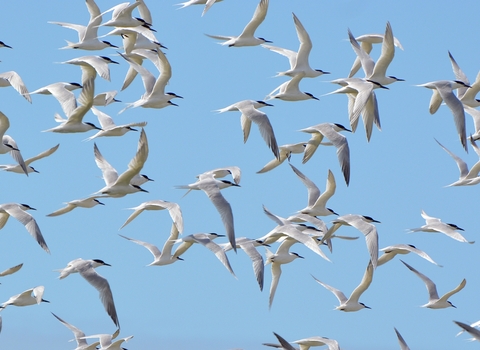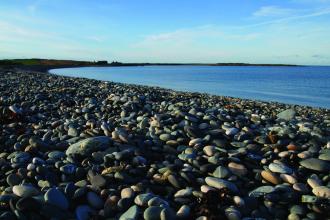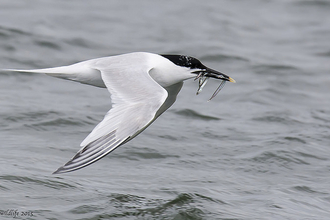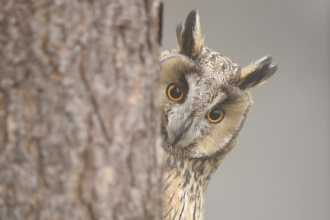Wedi ei ddiweddaru ddiwethaf 11 Chwefror 2025
Mae DEFRA yn disgrifio'r risg bresennol o HPAI mewn adar gwyllt fel un uchel. Mae hyn yn golygu bod achosion neu ddigwyddiadau o'r clefyd "yn digwydd yn aml iawn". Hyd at ddiwedd y mis roedd niferoedd yr adar gwyllt HPAI-positif yn lleihau.
Yng Nghemlyn a'n gwarchodfeydd natur arfordirol eraill ni byddwn yn cadw llygad barcud ar yr adar, yn enwedig wrth i gywion eleni ddechrau ymddangos. Byddwn yn adrodd am adar marw ac yn trefnu profion arnyn nhw yn ôl yr angen. Rydym yn parhau i weithio gyda'n cydweithwyr n yng Nghyfoeth Naturiol Cymru, Llywodraeth Cymr a’r Asiantaeth Iechyd Anifeiliaid a Phlanhigion i gydgysylltu adroddiadau a chamau gweithredu yn erbyn y clefyd hwn.
Yn y cyfamser, rydyn ni’n gofyn i’n hymwelwyr ni yng Nghemlyn a’n holl warchodfeydd ni ein helpu fel a ganlyn:
- Cadwch at y llwybrau a pheidio â tharfu ar yr adar mewn unrhyw ffordd.
- Cadwch gŵn ar dennyn a pheidiwch â gadael iddyn nhw darfu ar unrhyw fywyd gwyllt. Ewch ag unrhyw sbwriel a baw ci adref.
- Peidiwch â chyffwrdd ag adar sy'n sâl, wedi'u hanafu neu'n marw.
- Os gwelwch chi aderyn marw yn agos at ardal gyhoeddus, fel llwybr troed, rhowch wybod amdano drwy'r dolenni isod.
Roedd 2025 yn dymor da yng Nghemlyn, yn dilyn 2023 pan effeithiwyd ar y boblogaeth o fôr-wenoliaid yng Nghemlyn a’r gwylanod penddu cysylltiedig gan HPAI, gydag oedolion a chywion o bob rhywogaeth wedi’u heffeithio i raddau mwy neu lai. Roedd y boblogaeth o fôr-wenoliaid pigddu yn llai nag yn y blynyddoedd diwethaf hefyd. Gallwch ddarllen mwy am 2025 ar ein tudalen Darganfod môr-wenoliaid yng Nghemlyn.
Yn 2022 cafwyd dymor da yn Cemlyn gyda channoedd o gywion yn bwrw eu plu ond mewn mannau eraill tarodd ffliw adar yn ddramatig iawn. Collwyd ambell i gytref yn Yr Iseldiroedd (Den Noord) a Ffrainc (Oye-Plague) hyd at 70% o’i hadar. Ac yn y DU, fe oedd cytrefi o fôr-wenoliaid ar y arfordir dwyreiniol eu taro’n wael iawn. Caewyd yr Isle of May ac Ynysoedd y Farne i’r cyhoedd a chwalwyd cytref y môr-wenoliaid ar Ynys Coquet yn cynnwys poblogaeth sylweddol o Môr-wenoliaid gwridog. Mae’n edrych nad ydi cytrefi adar môr Iwerddon wedi dioddef.
Y darlun mwy
Yn anffodus, mae’r ffliw adar yn glefyd sy'n lledaenu rhwng adar gwyllt, ac adar dŵr fel gwylanod, hwyaid a gwyddau sy'n cael eu hystyried fel y rhai sy’n wynebu’r perygl mwyaf. Ni allwn stopio hyn rhag digwydd, ond gallwn helpu ein hadar gwyllt i fod yn iach a ffynnu, i wrthsefyll achosion o glefydau fel hyn. Maen nhw eisoes yn wynebu pwysau oherwydd colli cynefinoedd, llygredd a dirywiad mewn pryfed a ffynonellau bwyd eraill. Mae’n hanfodol ein bod ni’n gweld arweiniad cryfach ar helpu adar gwyllt i adfer drwy amrywiaeth o benderfyniadau polisi. Mae poblogaethau adar môr cyfan y DU mewn perygl o gael eu colli.
Y Sefyllfa Diweddarf
Mae DEFRA yn disgrifio'r risg bresennol o HPAI mewn adar gwyllt fel un uchel. Mae hyn yn golygu bod achosion neu ddigwyddiadau o’r clefyd yn digwydd yn aml iawn. . Mewn ymateb i’r bygythiad hwn, mae Defra a Llywodraeth Cymru wedi llunio canllawiau ymarferol i ymateb i’r bygythiad posibl. Mae’r ‘Strategaeth Liniaru ar gyfer y Ffliw Adar mewn Adar Gwyllt yng Nghymru a Lloegr’ yn nodi cynlluniau i liniaru effaith y ffliw adar ar boblogaethau o adar gwyllt a hefyd diogelu iechyd y cyhoedd, yr amgylchedd ehangach a’r economi wledig.
Gall ddarganfod y diweddaraf ar y sefyllfa yng Nghymru yma:
Ffliw adar: y diweddaraf (Llywodreath Cymru):
Diweddariadau rheolaidd ar gael hefyd gan lywodraeth y DU:
Bird flu (avian influenza): cases in wild birds - GOV.UK (www.gov.uk)
Rydym yn hynod bryderus am yr effaith y bydd yr achosion hyn yn ei cael ar ein poblogaethau o adar gwyllt sydd eisoes dan fygythiad ar adeg pan mae angen i ni ganolbwyntio ar feithrin gwytnwch mewn poblogaethau sy’n agored i niwed drwy fesurau adfer a gwarchod rhywogaethau.
Canllawiau DEFRA
Gall adar gael eu heintio gyda feirws ffliw adar drwy ddod i gysylltiad ag adar unigol sydd wedi'u heintio neu gynhyrchion gwastraff. Yn ogystal â dofednod domestig, gall adar gwyllt, gan gynnwys adar dŵr, gario a throsglwyddo'r feirws heb ddangos tystiolaeth o glefyd. Symud dofednod o amgylch y byd, symudiad adar gwyllt a mudo yw'r prif risgiau o ran trosglwyddo'r feirws.
Mae’r risg y bydd pobl yn dal ffliw adar gan adar gwyllt yn isel iawn, ond argymhellir o hyd i bobl beidio â chyffwrdd mewn adar sâl neu farw na’u codi. Rhowch wybod am fwy na 3 o adar dŵr gwyllt marw (elyrch, gwyddau neu hwyaid) neu adar môr, neu fwy na 5 aderyn arall neu 1 aderyn ysglyfaethus marw, i linell gymorth DEFRA (03459 33 55 77).
Ewch i wefan DEFRA am ragor o fanylion DEFRA
Gwefan Llywodraeth Cymru: WALES
Yr Effaith ar Waith Cadwraeth YNGC
Wrth i'r sefyllfa genedlaethol barhau i ddatblygu rydym wedi cyhoeddi canllawiau i staff a gwirfoddolwyr ar sut i ymateb pe baent yn dod ar draws adar marw. Fel rhan o'n gwaith iechyd a diogelwch parhaus rydym wedi diweddaru ac ychwanegu at ein canllawiau. Am y tro mae'r gwaith yn parhau yn ein gwarchodfeydd natur.
Bwydo Adar yr Ardd
Ar hyn o bryd yr awgrymiad yw glanhau y bwydydd adar yn wythnosol gyda diheintydd addas ac fod glanweithdra personol dda yn cael ei ddilyn tra yn gwneud hyn. Mae canllawiau pellach i gael ar wefan y BTO.
Darllenwch fwy am yr hyn y mae’r Ymddiriedolaethau Natur yn galw amdano
- Y Llywodraeth i ddatblygu strategaeth genedlaethol i helpu poblogaethau o adar gwyllt i adfer
- Systemau monitro, goruchwylio, ymchwil ac adrodd effeithiol ar waith i feithrin dealltwriaeth amser real o'r feirws a'i gynnydd mewn adar gwyllt
- Gwydnwch wedi'i ymgorffori mewn poblogaethau bregus drwy fesurau adfer a chadwraeth. Mae hyn yn cynnwys osgoi datblygiad niweidiol ar y môr a lleihau nifer yr adar môr sy'n cael eu lladd mewn sgil-ddalfa
- Y Llywodraeth i gyhoeddi moratoriwm ar ryddhau niferoedd mawr o adar hela estron pan mae’r ffliw adar yn bresennol ledled y wlad
- Dull newydd o ffermio dofednod – rydyn ni’n gwybod bod unedau dwys sy’n cadw miloedd o ieir ac adar domestig eraill mewn ysguboriau yn gwaethygu’r broblem o glefydau heintus, drwy ddarparu amodau delfrydol i bathogenau sy’n dod i’r amlwg ddatblygu, a all wedyn ledaenu i adar gwyllt
- Mwy o fuddsoddi mewn sut a pham mae hyn yn digwydd, er mwyn cael y siawns orau o osgoi trasiedïau tebyg yn y dyfodol
- Mwy o adnoddau i elusennau bywyd gwyllt a byd natur i helpu gyda monitro a mynd i'r afael â'r broblem
Amlygodd blog gan Joe Llanos o’r Ymddiriedolaethau Natur yr haint ffliw adar fel dim ond arwydd arall o’n ecosystem afiach.
Blog: Joe Llanos - Yr Ymddiriedolaethau Natur




